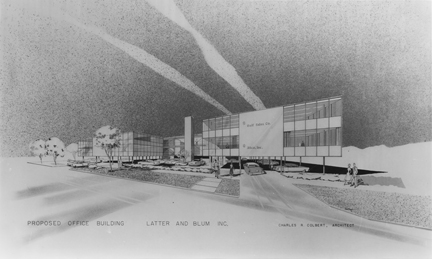Charles Colbert
Architect Charles Colbert's contributions to the shaping of mid-Twentieth Century architecture in southern Louisiana are profound.

Courtesy of The Historic New Orleans Collection
Proposed Office Building. Colbert, Charles (Architect)
Architect Charles Colbert’s contributions to the shaping of mid-twentieth century architecture in southern Louisiana are profound. Born in Oklahoma and raised in Texas, Colbert spent much of his career in New Orleans, where he designed a series of innovative schools. Rooted in contemporary materials and technologies and the aesthetics of modernism, his designs acknowledged regional historical forms while modifying them for contemporary needs and society. Perhaps more important than Colbert’s physical architectural legacy, though, was his significance as a planner, theorist, educator, and critic.
Early Life and Career
Charles Ralph Colbert was born June 23, 1921, in Dow, Oklahoma, and raised in Alvin, Texas. He earned a Bachelor of Architecture degree at the University of Texas, Austin, in 1943 and did postgraduate work in naval architecture at the University of Michigan at Ann Arbor from 1944 to 1945. He concluded his studies in 1947 with a Master of Science in Architecture from Columbia University. From 1943 to 1946, Colbert served in the U.S. Navy Construction Corps.
Colbert taught architecture at Tulane University from 1947 to 1949, leaving to take the position of supervising architect and director of the newly created Office of Planning and Construction for the Orleans Parish School Board. The position was established to resolve the deplorable conditions of the parish’s existing schools and the overcrowding generated by the post–World War II baby boom. During his directorship, Colbert prepared a study of short- and long-term needs for the parish’s schools. Subsequently, thirty new schools were constructed in the 1950s and 1960s. Colbert resigned from the position in 1952 to establish his own architectural office in New Orleans.
Practice in New Orleans
Colbert’s practice consisted primarily of schools, houses, small office buildings, motels, and urban planning in the New Orleans area. For some of his commissions he partnered with such architects as Raymond J. Boudreaux, Jack R. Cosner, Samuel Stewart Farnet, William J. Hess, Mark Lowrey, and Sol Rosenthal. He also designed several buildings in Texas and served as director of the Division of Architecture at Texas A&M University from 1956 to 1957.
The eight schools Colbert designed, some in collaboration with his occasional partners, all incorporated innovative structural or planning features. Hoffman Elementary, designed in 1948, was the first school building in New Orleans that was raised on stilts to provide a shaded play area beneath. Mahalia Jackson Elementary (formerly McDonogh #36), completed in 1953, had its classroom wings arranged around courtyards. Phillis Wheatley Elementary School (1954) is thought to be the first in the nation built with structural trusses; it also provided a shaded play area beneath the building. The Wheatley school garnered several national design awards, and the U.S. Department of State exhibited photos of it in Moscow. Colbert’s later schools revealed stylistic shifts, though always within a modernist language. At Helen Cox Junior High in Harvey (1965), Colbert addressed issues of climate control by including minimal openings and using masonry walls to resist sun exposure.
The modern house Colbert designed for his family in Metairie in 1957 was demolished following severe damage from Hurricane Katrina. The Kirschman House in New Orleans’s Lake Vista neighborhood, designed in 1960, is sheltered under truncated pyramid roofs and skylights to illuminate the interior. A similar geometry was repeated for the Simon House of 1960 in New Orleans, which is composed of four freestanding pavilions linked by glazed passages and covered by pyramidal roofs. Organized around an internal courtyard, each pavilion is devoted to a specific social or private family activity. Colbert stated that the geometric formality, order, and predictability of the plan gave a sense of security and comfort.
Other surviving works in New Orleans include a small clinic on Louisiana Avenue, built in 1963, in which the brise-soleil, composed of steel oil-field pipes, creates an abstract linear composition across the facade’s glass wall. He played with this feature in a different way for the former Olivetti Building (1966) on Canal Street. This showroom for the style-conscious Olivetti typewriter company has Colbert’s most rich and articulated exterior. His lively Motel de Ville (1955) on Tulane Avenue has been demolished, as was the one in Shreveport, but his Motel de Ville in St. Louis, Missouri, survives.
Later Career and Achievements
In 1960, Colbert accepted the position of dean of architecture at Columbia University. His tenure there was often controversial, in part because he reshaped the school’s curriculum to emphasize city and social planning rather than design. On his resignation in 1963, Colbert returned to Louisiana and established an architectural-urban planning practice in New Orleans. He also accepted occasional teaching positions as a visiting professor at Tulane University, Rice University in Houston, and, from 1972 to 1992, at Louisiana State University in Baton Rouge. Through his teaching, Colbert influenced generations of architects.
Charles Colbert’s projects, commentaries, and essays were included in all the major architectural journals as well as such mainstream magazines as Time and Popular Mechanics (this last included his project for a revolving wind house). His designs also were published in Mid-century Architecture in America (1961), Towards Better School Design (1954), and Who Designs America (1966). Recognized nationally for his knowledge of school design, Colbert participated in a Ford Foundation sponsored study of school organization and design in October 1959. He was made a Fellow of the American Institute of Architects in 1962. He also published three books setting out his ideas and gave many talks on architectural education, planning, and his work with the Orleans Parish school Board. Charles Colbert died February 12, 2007, in Metairie.
